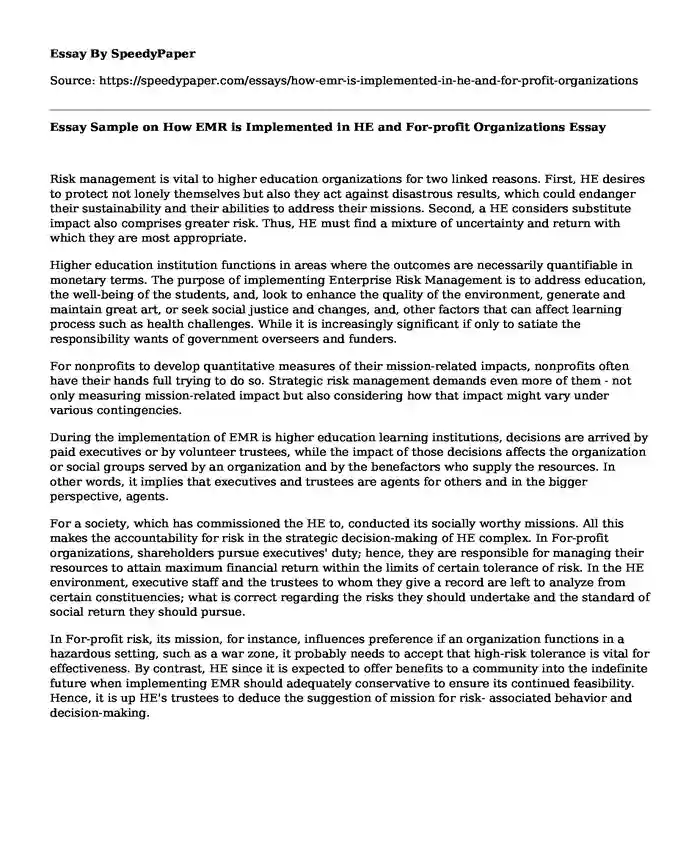
| Type of paper: | Course work |
| Categories: | Education Technology Risk management |
| Pages: | 2 |
| Wordcount: | 429 words |
Risk management is vital to higher education organizations for two linked reasons. First, HE desires to protect not lonely themselves but also they act against disastrous results, which could endanger their sustainability and their abilities to address their missions. Second, a HE considers substitute impact also comprises greater risk. Thus, HE must find a mixture of uncertainty and return with which they are most appropriate.
Higher education institution functions in areas where the outcomes are necessarily quantifiable in monetary terms. The purpose of implementing Enterprise Risk Management is to address education, the well-being of the students, and, look to enhance the quality of the environment, generate and maintain great art, or seek social justice and changes, and, other factors that can affect learning process such as health challenges. While it is increasingly significant if only to satiate the responsibility wants of government overseers and funders.
For nonprofits to develop quantitative measures of their mission-related impacts, nonprofits often have their hands full trying to do so. Strategic risk management demands even more of them - not only measuring mission-related impact but also considering how that impact might vary under various contingencies.
During the implementation of EMR is higher education learning institutions, decisions are arrived by paid executives or by volunteer trustees, while the impact of those decisions affects the organization or social groups served by an organization and by the benefactors who supply the resources. In other words, it implies that executives and trustees are agents for others and in the bigger perspective, agents.
For a society, which has commissioned the HE to, conducted its socially worthy missions. All this makes the accountability for risk in the strategic decision-making of HE complex. In For-profit organizations, shareholders pursue executives' duty; hence, they are responsible for managing their resources to attain maximum financial return within the limits of certain tolerance of risk. In the HE environment, executive staff and the trustees to whom they give a record are left to analyze from certain constituencies; what is correct regarding the risks they should undertake and the standard of social return they should pursue.
In For-profit risk, its mission, for instance, influences preference if an organization functions in a hazardous setting, such as a war zone, it probably needs to accept that high-risk tolerance is vital for effectiveness. By contrast, HE since it is expected to offer benefits to a community into the indefinite future when implementing EMR should adequately conservative to ensure its continued feasibility. Hence, it is up HE's trustees to deduce the suggestion of mission for risk- associated behavior and decision-making.
Cite this page
Essay Sample on How EMR is Implemented in HE and For-profit Organizations. (2022, Nov 07). Retrieved from https://speedypaper.com/essays/how-emr-is-implemented-in-he-and-for-profit-organizations
Request Removal
If you are the original author of this essay and no longer wish to have it published on the SpeedyPaper website, please click below to request its removal:
- Free Essay: Security Management Within the Industry
- Health Concepts in the Definition Essay Example
- Gag Reflex - Essay Sample for Your Inspiration
- Argumentative Essay Sample on Kids Playing Football
- Essay Sample: Impact of Gender on Doctor-Patient Interaction
- Free Essay - Government Paid College
- Free Essay. Own Experiences Concerning Sexual Abuse
Popular categories




